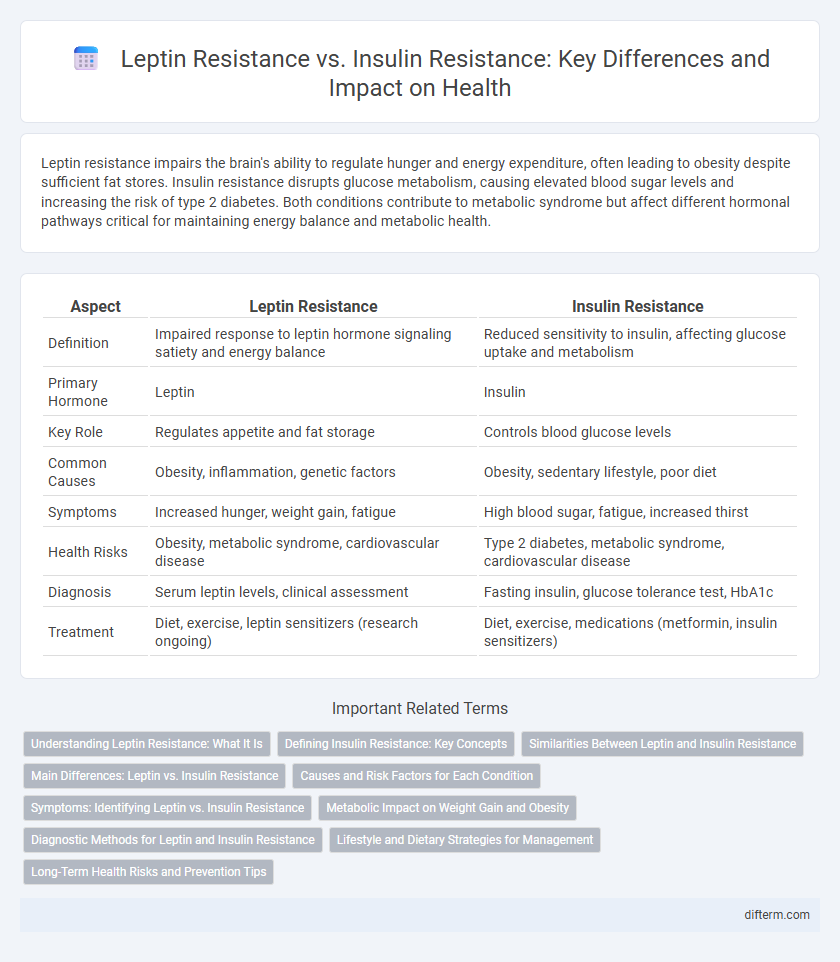Leptin resistance impairs the brain's ability to regulate hunger and energy expenditure, often leading to obesity despite sufficient fat stores. Insulin resistance disrupts glucose metabolism, causing elevated blood sugar levels and increasing the risk of type 2 diabetes. Both conditions contribute to metabolic syndrome but affect different hormonal pathways critical for maintaining energy balance and metabolic health.
Table of Comparison
| Aspect | Leptin Resistance | Insulin Resistance |
|---|---|---|
| Definition | Impaired response to leptin hormone signaling satiety and energy balance | Reduced sensitivity to insulin, affecting glucose uptake and metabolism |
| Primary Hormone | Leptin | Insulin |
| Key Role | Regulates appetite and fat storage | Controls blood glucose levels |
| Common Causes | Obesity, inflammation, genetic factors | Obesity, sedentary lifestyle, poor diet |
| Symptoms | Increased hunger, weight gain, fatigue | High blood sugar, fatigue, increased thirst |
| Health Risks | Obesity, metabolic syndrome, cardiovascular disease | Type 2 diabetes, metabolic syndrome, cardiovascular disease |
| Diagnosis | Serum leptin levels, clinical assessment | Fasting insulin, glucose tolerance test, HbA1c |
| Treatment | Diet, exercise, leptin sensitizers (research ongoing) | Diet, exercise, medications (metformin, insulin sensitizers) |
Understanding Leptin Resistance: What It Is
Leptin resistance occurs when the brain no longer responds effectively to leptin signals, disrupting the regulation of hunger and energy balance and often leading to overeating and weight gain. Unlike insulin resistance, which primarily affects blood sugar control and is a key factor in type 2 diabetes, leptin resistance impairs the body's ability to sense fat stores and control appetite. Understanding leptin resistance involves recognizing its role in obesity and metabolic disorders, highlighting the importance of targeting leptin pathways for effective weight management and metabolic health.
Defining Insulin Resistance: Key Concepts
Insulin resistance is a metabolic condition where cells in muscles, fat, and the liver become less responsive to insulin, leading to impaired glucose uptake and elevated blood sugar levels. This dysfunction contributes to the development of type 2 diabetes, obesity, and cardiovascular diseases. Understanding the molecular mechanisms involving insulin receptor signaling pathways is crucial for diagnosing and managing insulin resistance effectively.
Similarities Between Leptin and Insulin Resistance
Leptin resistance and insulin resistance share key similarities in disrupting metabolic regulation, as both impair hormone signaling pathways essential for energy balance and glucose homeostasis. These resistance states contribute to obesity and type 2 diabetes by promoting increased appetite, reduced energy expenditure, and impaired insulin sensitivity. Chronic inflammation and cellular stress are common underlying mechanisms exacerbating the dysfunction of leptin and insulin signaling in target tissues.
Main Differences: Leptin vs. Insulin Resistance
Leptin resistance primarily disrupts the brain's ability to regulate hunger and energy expenditure, leading to persistent feelings of hunger despite adequate fat stores, whereas insulin resistance affects cells' ability to absorb glucose, causing high blood sugar levels and increased risk of type 2 diabetes. Leptin resistance is often linked to obesity and impaired signaling in the hypothalamus, while insulin resistance involves metabolic dysfunction in muscle, liver, and fat tissues. Understanding these differences is crucial for targeted treatment approaches in metabolic and hormonal disorders.
Causes and Risk Factors for Each Condition
Leptin resistance primarily arises from chronic inflammation, high-fat diets, and obesity, disrupting the brain's ability to regulate hunger and energy balance. Insulin resistance is commonly caused by excess visceral fat, physical inactivity, and high sugar intake, impairing glucose uptake and increasing diabetes risk. Both conditions share obesity as a significant risk factor but differ in their molecular pathways and metabolic consequences.
Symptoms: Identifying Leptin vs. Insulin Resistance
Leptin resistance symptoms include persistent hunger despite adequate food intake, difficulty losing weight, and increased appetite, often accompanied by fatigue and brain fog. Insulin resistance symptoms manifest as elevated blood sugar levels, frequent hunger, increased thirst, and weight gain, especially around the abdomen. Both conditions share overlapping signs, but leptin resistance primarily affects appetite regulation, while insulin resistance disrupts glucose metabolism and energy use.
Metabolic Impact on Weight Gain and Obesity
Leptin resistance impairs the brain's ability to regulate hunger and energy expenditure, leading to increased appetite and reduced fat burning that contribute significantly to weight gain and obesity. Insulin resistance disrupts glucose metabolism, causing elevated blood sugar levels and promoting fat storage, which exacerbates metabolic dysfunction and obesity. Both conditions interplay to worsen metabolic health by promoting chronic inflammation, hormonal imbalance, and impaired energy homeostasis.
Diagnostic Methods for Leptin and Insulin Resistance
Leptin resistance diagnosis primarily involves measuring serum leptin levels alongside clinical assessment of obesity and metabolic markers, with leptin-to-adiponectin ratio serving as a key indicator. Insulin resistance is commonly diagnosed using the Homeostatic Model Assessment for Insulin Resistance (HOMA-IR), fasting insulin and glucose tests, and the oral glucose tolerance test (OGTT) to evaluate insulin sensitivity. Advanced diagnostic methods for both conditions include molecular biomarkers and imaging techniques to assess adipose tissue function and pancreatic beta-cell activity.
Lifestyle and Dietary Strategies for Management
Leptin resistance and insulin resistance both impair metabolic regulation but require tailored lifestyle and dietary strategies for effective management. Emphasizing a high-fiber, low-glycemic index diet helps improve insulin sensitivity, while consuming anti-inflammatory foods rich in omega-3 fatty acids supports leptin receptor function. Regular physical activity combined with stress reduction techniques enhances hormonal balance, promoting better regulation of appetite and glucose metabolism.
Long-Term Health Risks and Prevention Tips
Leptin resistance and insulin resistance both contribute significantly to metabolic disorders, increasing the risk of type 2 diabetes, cardiovascular disease, and obesity-related complications. Chronic leptin resistance disrupts appetite regulation and energy balance, while insulin resistance impairs glucose metabolism, leading to prolonged inflammation and organ damage. Preventive strategies include maintaining a balanced diet rich in whole foods, regular physical activity, and managing stress to improve hormonal sensitivity and reduce long-term health risks.
Leptin resistance vs insulin resistance Infographic

 difterm.com
difterm.com